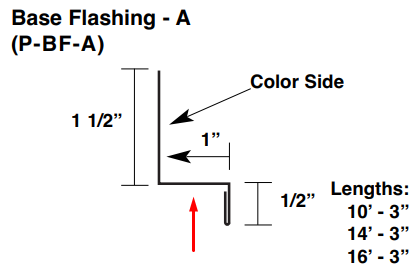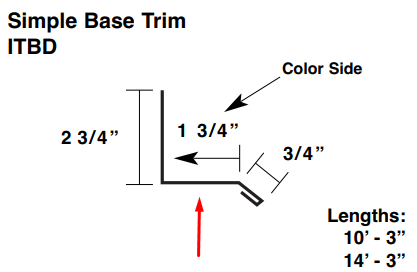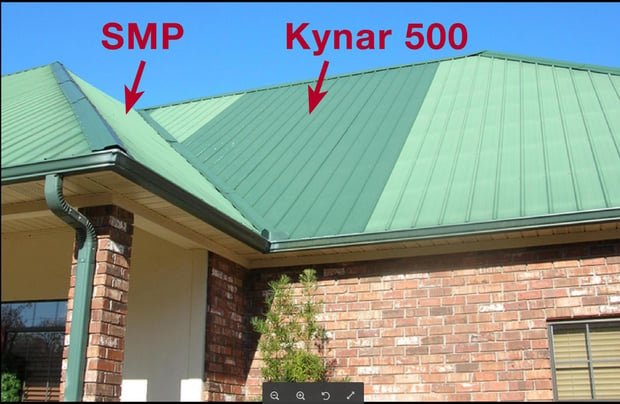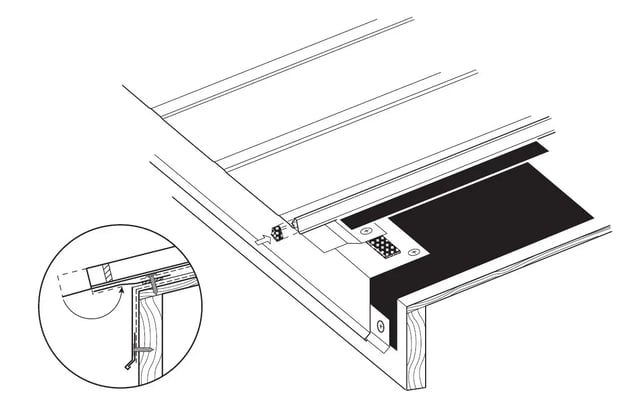- Home
- Products
- Accessories
- Trim Overview
Metal Wall and Roof
Trim & Flashing Information
Trim Names & Locations
The trim used on metal panel projects serves two primary purposes. First and most important, trim is used to seal the building envelope and prevent water, dirt, sand, and other foreign debris from entering the building. Secondly, through color and shape, trim can add to the overall aesthetic statement of the building. If you're unfamiliar with the various trims used on a building with metal panels, learning the names and locations of each trim piece is a great place to build your understanding and vocabulary! Watch the video below to learn more!
Trim Overview
From manufacturing differences to installation quality, it's often said that trim makes the difference between a good building and a GREAT building! Needless to say, it's vital to understand a few basics, like paint system options, attachment methods, yield strength, and more. Click on the various links below to learn more.
- Product Specific
- Paint System
- Trim Attachment Method
- Trim Style Standards
- Yield Strength
Product Specific
Some trim shapes can be interchanged with multiple panel types, and based on the height of the major rib, others cannot.
One of the easiest ways to understand this is by looking at a Base Trim. The top image shows a 1" horizontal measurement on the trim where the panel rests. This trim is designed for panels with major ribs 3/4" or less.
In contrast, the trim in the second image shows a horizontal measurement of 1 3/4" and is designed for panels with major ribs of 1 1/4" or less. While you could install a panel with either a 3/4" tall or 1 1/4" tall major rib on the bottom trim, you could not install a panel with a 1 1/4" rib height on the top trim image.
Consequently, it’s essential to select the corresponding trim for the specific panel on the project.


Paint System
Like coating systems for panels range from good, better to best, the same applies to the paint coating for trim materials.
At McElroy Metal, we’re proud to be one of the few manufacturers to offer PVDF/Kynar 500® coatings for our entire product line. We’ve taken that position because we believe in the superior fade and chalk resistance of Kynar 500 products.
If you aren’t familiar with the long-term benefits of Kynar 500 painted products, learn more about them here.

Trim Attachment Method
It’s also important to consider how the trim is attached to the building.
As the name implies, exposed fastener trim is attached to the panel and substructure with a screw that pierces all three components (trim, panel, and substrate.) As might be expected, exposed fastened trim is the most economical to purchase and install.
In contrast, concealed fastener trim uses various cleats attached to the structure, which allow the final trim pieces to hook or engage via an open hem. While concealed trim applications may use pop rivets at trim laps, they do not involve any visible screws.

Trim Style Standards
Due to the lower price point and ease of installation, post-frame and commercial applications routinely use exposed fastener trim installations.
In contrast, the desired aesthetics and system life expectancy push most architectural applications toward concealed fastener systems. where the use of cleats, open hems, and pop rivets replace larger visible fasteners.
Residential applications flex either way. For the budget-conscious owner who doesn't mind a bit of maintenance, exposed fastener trim details can work quite well. And for the discerning owner with little appetite for minimal maintenance, concealed fastened trim attachment remains the preferred approach.
Yield Strength
Yield strength (measured in PSI) is the resistance the steel has to deforming when pressure is applied. The three most common strengths, from strongest to weakest, are 80,000, 50,000 & 37,000 PSI.
Since they are lighter and less rigid, 29 gauge panels generally use stronger 80,000 PSI material to help the panels carry the necessary load.
However, trims made from 80,000 PSI can microfracture at tight bends and hems, which leads to rust and premature failure. To avoid those issues, some manufacturers skip the hem entirely for their 29 gauge trims, leading to safety issues and a wavy trim appearance.
At McElroy Metal, we've chosen to inventory 80,000 PSI material for our 29 gauge panels and 37,000 PSI, for our 29 gauge trims. Sure, it costs a bit more to inventory two different coils, but to us, it's the right decision to ensure the best quality and aesthetics for your project!

Panel Specific Trims
As mentioned earlier, matching the trims to the selected panel style is essential.
Panel Specific Trims
As mentioned earlier, matching the trims to the selected panel style is essential.
Post-frame trims are typically installed with exposed fasteners and produced from 29 gauge steel.
Since post-frame structures can be quite large, the trims tend to be bigger and bolder than what might be used in a residential application.
This trim style is what we use for panels like our Max Rib and Mesa. To view trim drawings and installation for these systems, click here.
Residential trim styles are typical for panels like our Meridian, Max-Rib & Mesa. Residential trim pieces tend to be smaller and produced standard in 26 gauge to help reduce oil canning.
Click the appropriate panel name to view trim drawings for our Meridian, Max Rib, and Mesa panels. Be sure to note that there are options for both exposed fastener and architectural (concealed fastener) attachment methods for Meridian.
Commercial/industrial trim pieces install with exposed fasteners and tend to be larger in size.
Thru Fastened Panels: These 26 gauge trim styles are popular for panels like our: Multi-Rib, R-Panel, Multi-Cor & M-Cor, U-Panel, Multi-V, and Mini-Rib.
Standing Seam Panels: Our Maxima and Masterlok 90/Masterlok FS systems can also be installed with a commercial/ industrial trim package and exposed fasteners.
Our architectural trim offering utilizes concealed fastener attachment and is produced standard in 24 gauge.
Architectural trims normally use a series of cleats and metal zee flashing to enable installation with no exposed fasteners.
Click on the appropriate link to see the trim details for the panel under consideration: Maxima; Medallion Lok; Mirage II; Medallion I & II.
Post-frame trims are typically installed with exposed fasteners and produced from 29 gauge steel.
Since post-frame structures can be quite large, the trims tend to be bigger and bolder than what might be used in a residential application.
This trim style is what we use for panels like our Max Rib and Mesa. To view trim drawings and installation for these systems, click here.
Residential trim styles are typical for panels like our Meridian, Max-Rib & Mesa. Residential trim pieces tend to be smaller and produced standard in 26 gauge to help reduce oil canning.
Click the appropriate panel name to view trim drawings for our Meridian, Max Rib, and Mesa panels. Be sure to note that there are options for both exposed fastener and architectural (concealed fastener) attachment methods for Meridian.
Commercial/industrial trim pieces install with exposed fasteners and tend to be larger in size.
Thru Fastened Panels: These 26 gauge trim styles are popular for panels like our: Multi-Rib, R-Panel, Multi-Cor & M-Cor, U-Panel, Multi-V, and Mini-Rib.
Standing Seam Panels: Our Maxima and Masterlok 90/Masterlok FS systems can also be installed with a commercial/ industrial trim package and exposed fasteners.
Our architectural trim offering utilizes concealed fastener attachment and is produced standard in 24 gauge.
Architectural trims normally use a series of cleats and metal zee flashing to enable installation with no exposed fasteners.
Click on the appropriate link to see the trim details for the panel under consideration: Maxima; Medallion Lok; Mirage II; Medallion I & II.
Trim Options
You may have additional trim options depending on the manufacturer you partner with. We’re pleased to offer hems, long trim lengths, various trim gauges, and even custom trims at McElroy Metal.
See the details below to learn more.
Hems
Hems are created by folding the material to 180 degrees. Our standard is 1/2' minimum, but we can do longer if requested.
Hems reduce oil-canning, and stiffen the trim, which makes it much easier to handle. Hems also reduce the likelihood of anyone being cut by the metals’ sharp edges.
Some of our standard trims include hems, while others do not; however, hems are available on most trim pieces upon request.
Trim Length
Most manufacturers offer trims in lengths ranging from 10’3" to - 20’3", with the shorter lengths costing more per foot than longer lengths.
Maximizing trim length allows for better appearance; quicker installation, and fewer trim laps which equate to fewer opportunities for water and snow to enter the structure.
Consequently, to help our customers minimize trim laps, most of our facilities can produce trims in lengths up to 20’3". Feel free to contact us to learn more.
Trim Gauges
The gauge of trim affects cost, oil canning, and even how quickly it installs. Oil canning is most troublesome for large and highly visible trim pieces like those found on ridge caps, rakes, fascias, and parapet caps. Many installers choose to have these larger trim shapes produced in a heavier gauge to minimize the effects of oil canning.
At McElroy Metal, we use the following standards for our trims: post-frame-29 gauge, commercial-26 gauge, and architectural 24 gauge. If your project specifics require something different, just let us know!
Standard vs. Custom Trims
While standard trims are almost always more cost-effective, at McElroy Metal, we produce nearly as much custom trim as our standard shapes. In some cases, project specifics demand custom shapes, and in others, our builders prefer to use their own signature pieces.
Bottom line: Our high-end equipment allows us to produce almost any trim shape necessary, so don’t hesitate to let us know if you prefer something different than one of our standard shapes.




